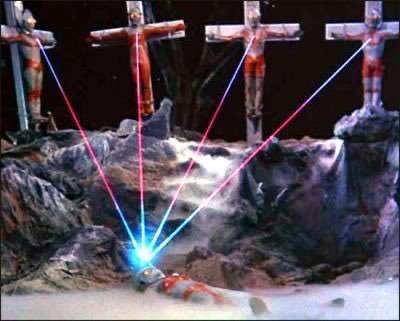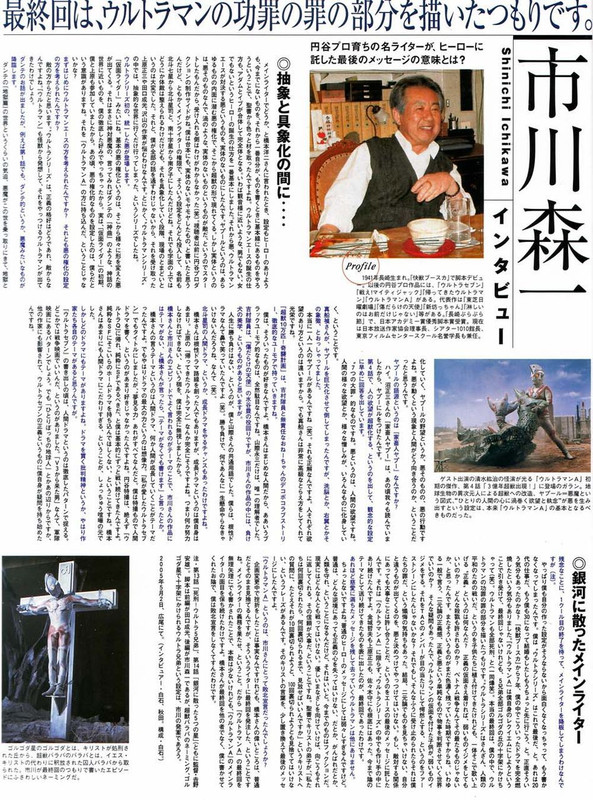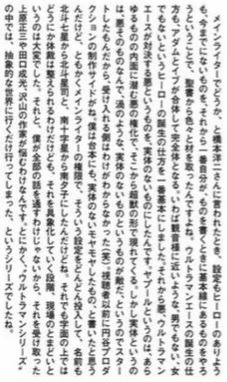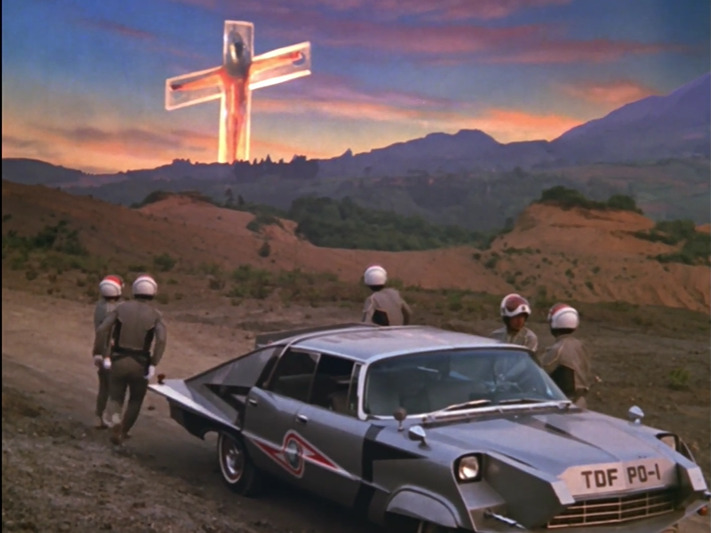eiji tsuburaya wasn't the cs lewis of tokusatsu
So it's become a common bit of trivia that Eiji Tsuburaya converted to Catholicism, and that's true. Something that often goes along with that trivia among toku fans and NGE discussions people talking about Christian iconography in Japanese media is the claim that elements of Christianity were deliberately included in Ultraman by Tsuburaya, and I've been trying to verify this, but I haven't seen enough evidence for that being the case. If anyone has reliable sources to share about this, I'd appreciate hearing it.
From what I've scoured from English and Japanese sources online, the extent of what is known about Eiji Tsuburaya's relationship to Catholicism is that he was baptized in 1960 due to his wife Masano's influence, his kids were raised Catholic because of her, and he was buried in a Catholic cemetery. I haven't found any sources talking about his faith in detail or indicating that he meant to incorporate Christianity in Ultraman by design.
From Eiji Tsuburaya's Wiki page
"Akira was the first of the couple's sons to be baptized, since Masano had been converted to Catholicism by her younger sister. Masano persisted in introducing her children to the Catholic faith and ultimately converted her husband." [Ragone, August (May 6, 2014). Eiji Tsuburaya: Master of Monsters (paperback ed.). Chronicle Books. ISBN 978-1-4521-3539-7.]
"His funeral was held at the Seijō Catholic Church on January 29, with his eldest son Hajime serving as the chief mourner." [Shiraishi, Masahiko (July 20, 2006). 円谷一 ウルトラQと"テレビ映画"の時代. Futabasha. ISBN 978-4-5752-9907-6.]

From episode 14 of Ultraman Ace
The explicit references to Christianity throughout Ultraman Ace and the infamous crucifixion of the Ultrabros above are sometimes misattributed to Tsuburaya. Tsuburaya had no involvement with Ace at all, as it was made 2 years after his passing, and it is also known that the person responsible for the Christian motifs in Ace, as well as several elements of Ultraseven, was the writer Shinichi Ichikawa.
From Shinichi Ichikawa's Wiki page
"キリスト教の信仰を持つに至ったのは、10歳で亡くした実母の入院先が長崎市内のカトリック系の病院だったことが契機とされている。" [切通理作「第四章 市川森一 永遠の浮遊者 2 他人の星」『怪獣使いと少年 ウルトラマンの作家たち』宝島社、1993年7月7日、ISBN 4-7966-0671-8、249頁。]
(It is believed that he became Christian when his mother, who died when he was 10, was hospitalized in a Catholic hospital in Nagasaki.)
"プロテスタント信者であり、洗礼を受けたのは日本基督教団諫早教会であった。" [“市川森一夢紀”. 鎮西学院高等学校 (2018年4月20日). 2021年6月5日閲覧。]
(He was baptized Protestant at the Isahaya Church of the United Church of Christ in Japan.)
"キリスト教による影響が随所に見受けられ、ウルトラシリーズの脚本では、新約聖書や神話に由来する名前を持つ怪獣や設定を多用したことでも知られる(サイモン、ペテロ、バラバ、ゴルゴダの丘→ゴルゴダ星、アイスキュロス→アイロス星人、マナ→フルハシ・マナ、プロメテウス→プロテ星人、サロメ→サロメ星人など)" [切通理作「第四章 市川森一 永遠の浮遊者 2 他人の星」『怪獣使いと少年 ウルトラマンの作家たち』宝島社、1993年7月7日、ISBN 4-7966-0671-8、249頁。]
(Christian influences can be seen thoughout his work, and his scripts for the Ultra series are known for including many kaiju and settings with names derived from the New Testament and mythology (Simon, Peter, Barabbas, Golgotha Hill -> Planet Golgotha, Aeschylus -> Alien Iyros, Mana -> Mana Furuhashi, Prometheus -> Alien Prote, Salome -> Alien Salome, etc.))


Interview with Ichikawa from KODANSHA Official File Magazine ULTRAMAN 6
(When Youji Hashimoto asked me about becoming the head writer, to do something that hadn't been done before, and to write a foundation for the setting and hero, I took material from the Bible. The birth of Ultraman Ace was like Adam and Eve uniting to become one whole. The foundation was created for a hero that was neither man nor woman, like Kannon. Then, the evil that Ultraman Ace confronted was abstract. Yapool, a kaiju that was the embodiment of the evil lurking within all beings, appeared.)
I'm guessing that this misattribution is what has influenced a lot of the claims about Tsuburaya.

From episode 39 of Ultraseven
Tsuburaya was alive and in charge of TsuPro when Seven was crucified, but there's nothing in the content of this episode or info regarding its production that would particularly designate it as being a Christian symbol over simply being a method of execution for Seven. It is also hard to determine how involved Tsuburaya would have been in developing this plot, if at all.
I've often seen the claim that the Spacium Beam pose is based on the cross, but Bin Furuya, Ultraman's suit actor, has said that he came up with it from a pro wrestler move and it was adjusted to leave the color timer more visible and make the beam easier to edit in post.
From Tamashii Nation's interview with Bin Furuya
"So it was modeled after a Showa Era Professional wrestler’s special move."
"Basically, he was my childhood hero. He defeated so many foreign wrestlers with a single move. It truly is just like Mito Kumon’s inro. I created the pose with the Karate Chop as the base, while consulting the Director Toshihiro Iijima and the Optic Photographer Minoru Nakano. I also thought about having the Color Timer be visible in the shot. The Director or Cameraman didn’t tell me to do this, I just thought it’d be cool if it were visible in the pose. I practiced in front of the three-sided mirror at least 300 times a day, thinking about how it would look on camera."
From Ultraman (1966)'s Wiki page
"ポーズは力道山の空手チョップを参考にしており、右手を手刀にして縦にしたものだが、そのままでは合成した際にぶれてしまうことから右手は反らずに少し力を抜いて、左手を添えて腕を十字に組んだものとなった。" [講談社編『ウルトラ特撮 PERFECT MOOK』 講談社〈講談社シリーズMOOK〉。vol.02 《ウルトラマン》、2020年7月28日。ISBN 978-4-06-519603-8。]
(The pose was based on Rikidouzan's karate chop, with the right hand vertical in a chop position, but since it would blur in compositing, the right hand was then relaxed and the left hand supported the right in a cross shape.)
Anyway... I'm not saying that it's impossible for Tsuburaya to have been influenced by Christianity when it came to making Ultraman, it just seems that the way that people talk about Tsuburaya and Christianity has become somewhat apocryphal and misrepresents the work that he and Ichikawa did.